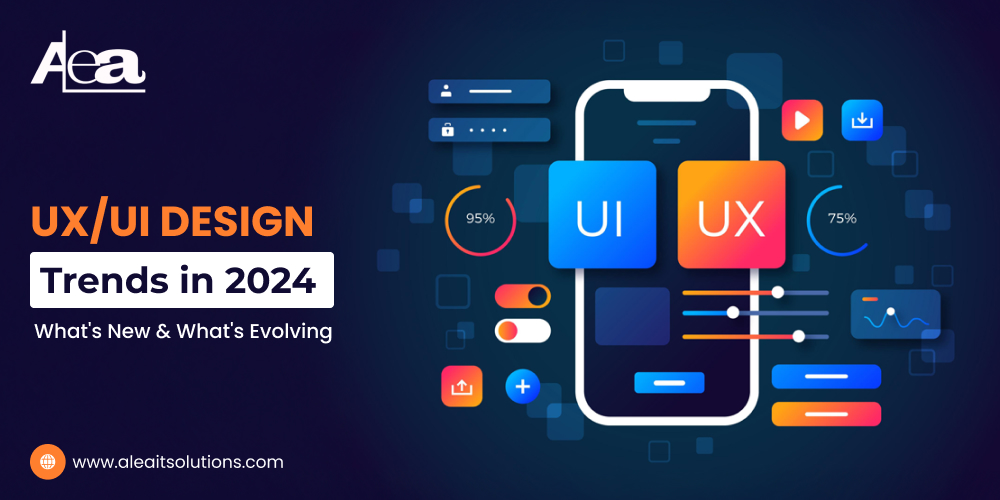Entering in 2024, the UX/UI design is developing more than before, combining state-of-the-art innovations with refined techniques to align with user needs. Inspired by sharp-transport technological progress, transferring the expectations of the user, and focusing a strong focus on inclusion, the purpose of this year’s design trends is to create attractive, accessible and beautiful interfaces. Let’s dive into the top UX/UI trends that shape 2024, both interface and experience are merged with innovation and development to create attractive and highly functional experiences.
1. Minimalism with a Bold Twist: Statement-Making Simplicity
Minimalism is a stronghold in UX/UI, but in 2024, it is getting a vibrant twist. Designers are moving beyond the basic tone, including bold colors to add personality in simplicity, standout typography and eye-catch icons.
- Why it works: A minimum design with bold elements increases the purposeful and keeps the interface clean and distraught.
- How to apply: Choose a core color palette with one or two accent colors, and use large, different design elements to draw attention to the required material.
2. Enhanced 3D Elements and Immersive Visuals
With the development of AR/VR, 3D graphics and immersive visual digital experiences feel more tangible. Users appreciate the interfaces that add depth and interaction, leading to a lifetime environment that increases engagement.
- Why it works: 3Ds produce visual depth, which makes the interface feel interactive and attractive.
- How to apply: Integrates the subtle 3D graphics in the performance or navigation elements of the products, which added to the users to the added realism.
3. AI-Driven Personalization and Adaptive UX
This year, privatization is more than a simple greeting. The AI-manufactured design now optimize layouts, colors and materials based on individual user behavior and preferences, creating a specific sewn experience.
- Why it works: Personal design provides relevant materials and intuitive navigation, which leads to high user engagement.
- How to apply: Use machine learning to study user interactions, adopt layouts and material recommendations to match user preferences.
4. Thoughtfully Designed Micro-Interactions
In 2024, micro-interactions are prepared more carefully than before, making the user experiences attractive and smooth. Simple animation – such as lighting on a button hover or a sound effect with a swipe guide users and make the interaction enjoyable.
- Why it works: Micro-intermission provides immediate feedback, increasing the user’s overall experience.
- How to apply: Focus on major interactions, adding animations that increase tasks such as swiping or forming form.
5. Accessibility and Inclusivity as Essentials
Inclusion is no longer optional – this is necessary. Designers are creating more accessible interfaces with facilities such as adjustable text size, voice navigation and screen-reader compatibility, ensuring that everyone can easily access digital content.
- Why it works: Sulabh designs make your audience access to wider, showing a commitment to inclusion.
- How to apply: Use the tool for color contrast checking, text options for images, and settings that allow users to personalize their experience.
6. Neo-Brutalism and Nostalgia in Design Aesthetics
The neo-crushing-a comeback described by bold and unattainable elements is looking at a comeback. Pixel art of 8000s combined with indifferent design trends, these aesthetics bring personality and create emotions, standing out of modern designs.
- Why it works: Neo-crusality and apathy add character to a brand, making it more memorable.
- How to apply: Use bold fonts, vibrant colors and unconventional layouts for neo-criminalism. For apathy, blend retro elements with modern purposes.
7. Voice and Gesture-Driven Interactions
As more smart devices embrace the identity of voice and gesture, these features are increasing in the mainstream UX/UI. The voice-activated command and gesture-based navigation provides users a hand-free and accessible experience, changing how they interact with digital products.
- Why this works: voice and gesture interfaces allow fast, touchless interaction, benefiting users who prefer hands-free options.
- How to apply: Consider adding the recognition of voice or gesture for specific functions such as navigation or activation commands.
8. Ethical and Sustainable Design Practices
With an increase in digital activity, designers are considering the environmental and moral effects of their work. Sustainable UX/UI includes features such as dark mode and data-light layout, while moral design prefers transparency, avoiding manipulative strategy.
- Why it works: Ethical and durable design manufactures user trusts, which appeals to those of their digital footprints.
- How to apply: Use dark mode, reduce data-enlargement elements, and ensure that UX writing promotes informed decision making.
9. Data Visualization and Infographics
In a data-operated world, effective data presentation is necessary. The UX/UI interactive data is embracing visualization and infographics, allowing users to easily and easily understand complex information.
- Why it works: Visual data helps users to understand the information quickly, simplifying complex themes.
- How to apply: Integrate charts or interactive graphics on data-loyal pages and customize them for both desktop and mobile devices.
10. Augmented Reality (AR) Enhancements
The AR user is redefined again, providing an immersive method to detect products or environment. From trying on virtual outfits to preview household items, AR brings digital experiences to life.
- Why it works: AR provides experience on a hand, making digital interactions more individual and memorable.
- How to apply: Try to use AR for product preview, virtual tourism, or interactive guides, allowing users to find in real time.
Conclusion
In 2024, UX/UI focuses on creating experiences that are not only visually stunning, but also accessible, individual and emergent. Trends such as bold minimalism, 3D visual and adaptive interfaces are shaping a digital world where users feel valuable and engaged. Thinking of these trends can promote the user’s satisfaction and loyalty, so that your brand can be reached to the next level.
In Aleait Solutions, we are ahead of these trends to create a standout digital solution. Whether you are refreshing your design or building a brand-new interface, we are here to help.
Contact us to see how we can bring these trends in our next project!




